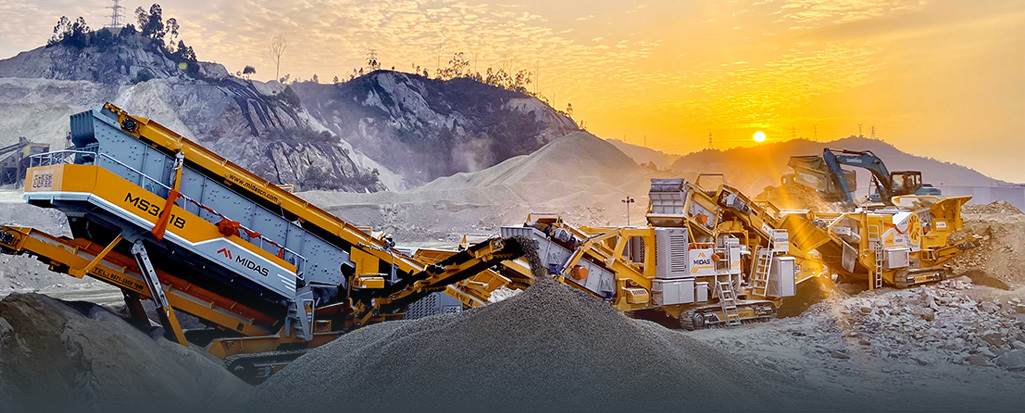Advantages and disadvantages of three sand making processes of mobile crushing and sand making equipment.
【Summary Description 】The typical dry sand production process is mainly as follows: the crushed stone particle size needs to be controlled within the range of 5-40mm, and it is provided to the sand making machine as raw material.
1. Production process of mobile crushing machine sand making equipment
1. Fully dry method
The typical dry sand making production process is mainly that the size of the crushed stone needs to be controlled within the range of 5-40mm, and it is provided to the sand making machine as raw material, and through the full use of the screening and grading equipment, the fine crushed stone with a particle size of 2-5mm and the crushed stone with a particle size greater than 5mm are returned to the sand making machine for reprocessing.
In addition, the raw materials with a particle size less than 2.5mm are subdivided into two grades, less than 0.6mm and 0.6-2.5mm, and the excess stone powder of the fine sand material with a particle size less than 0.6mm is removed by the air classifier, and then the three materials of 2.5-5mm, 0.6-2.5mm and less than 0.6mm are evenly mixed by the mixing equipment. This approach can ensure that the quality of each material meets the product specifications required by artificial sand.
This process technology does not require water to be added to the overall processing system of the system, and rain protection measures need to be adopted in the sand making related links. The alloy rubber sweeper needs to be installed at the head of the belt conveyor to promote the increase of stone powder recovery.
2. Semi-dry method
In the production process of this sand making technology, there are mainly three kinds of raw materials entering the silo for sand making: coarse aggregate with a particle size of 5-40mm after crushing and grading; aggregate with a particle size of 2.5-40mm returned by the sand screening building; slag after dehydration after grading the finished coarse aggregate with a particle size of 2.5-5mm.
From the process level, this process can effectively control the mud content of the sand making raw materials. The finished sand entering the sand storage is mainly divided into the following three types: grading and screening of coarse aggregate sand with a particle size less than 5mm; finished fine sand with a particle size less than 2.5mm recovered from sewage after grading coarse aggregate; fine sand with a particle size less than 2.5mm.
Semi-dry production technology can effectively solve the problem of large mud content and soft rock. It can be divided into semi-dry production process based on dry method and semi-dry production process based on wet method according to the quality of raw materials. The production of sand and gravel aggregates by semi-dry method can not only improve the quality stability, but also will not produce dust pollution, which is very applicable to all kinds of raw materials. However, because the process method needs to treat a large amount of sewage, which is a major defect and deficiency, sewage treatment will incur certain treatment costs and have high costs.
3. Wet method
At present, many hydropower projects in my country use wet production and need to use special purification equipment to effectively treat mud and sewage. The wet sand making process is mainly characterized by the following process characteristics: inspection screening and vertical shaft impact crusher form a closed loop, and two screens of 5mm and 3mm are set on the inspection screen. After dehydration and classification, the rod mill products and particles with a particle size of less than 3mm directly enter the finished sand bin, and particles with a particle size of 3-5mm need to enter the rod mill again, and particles larger than 5mm need to be crushed again.
2. Measures to improve the quality of mobile crushing and sand making equipment
1. Coating of coarse aggregate
The corresponding flushing process is set in the processing system to effectively remove the powder on the aggregate, but special equipment is needed to deal with the mud on some aggregates.
Using a long spiral classifier to grade and wash stones with a particle size of no more than 5mm can effectively remove clay and mud to a large extent. If the source contains some tuff interlayers and other rocks that are difficult to remove, it is easy to produce extremely serious powder after secondary crushing, causing the mud content in the finished material to exceed the limit.
Therefore, no matter what kind of screening form, not only the use of soil disposal equipment is required, but also the configuration of related washing processes.
2. Particle grading
The application of high-grade sand in construction can achieve a substantial saving of cement on the one hand, and on the other hand, it can also promote the effective improvement of concrete strength. If the proportion remains unchanged, but the coarse sand will cause the cohesiveness of the concrete to be poor, which will lead to the easy separation of the concrete.
If the sand is too fine, even if the concrete is highly cohesive, its fluidity will be greatly weakened, thus increasing the amount of cement, resulting in an increase in construction costs, and also having an adverse effect on the strength formation of concrete.












